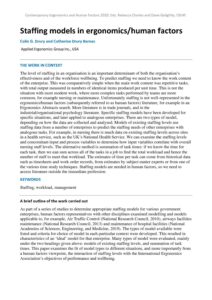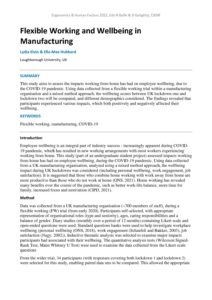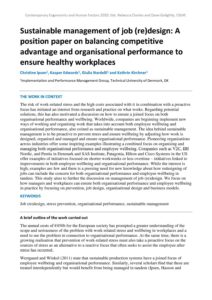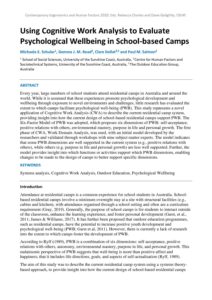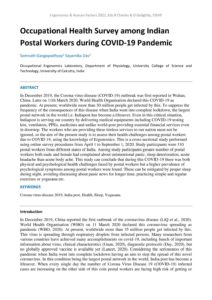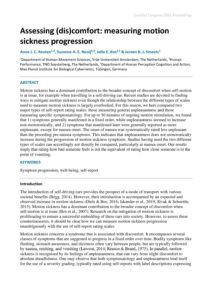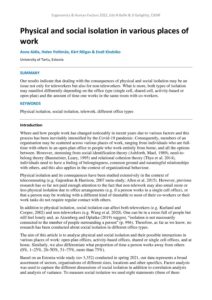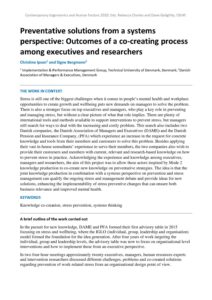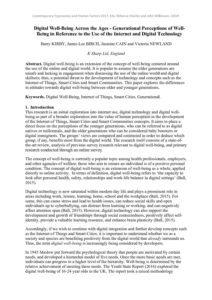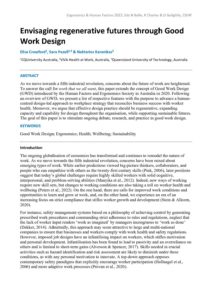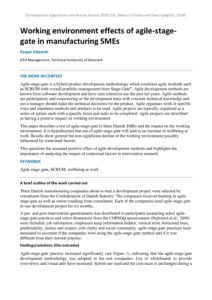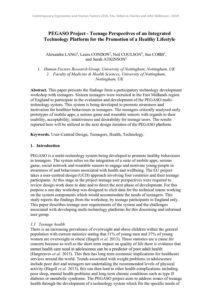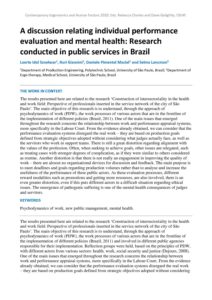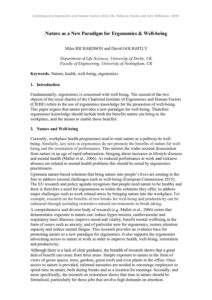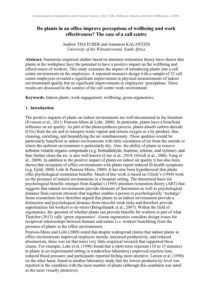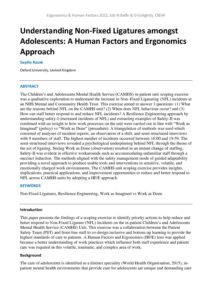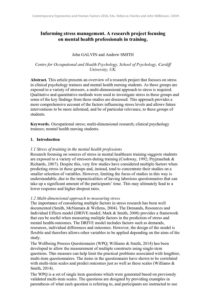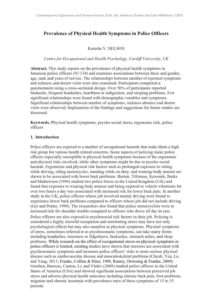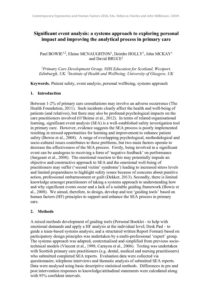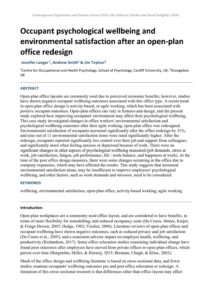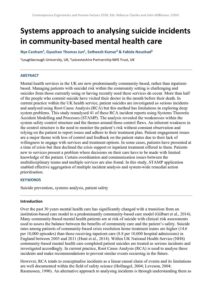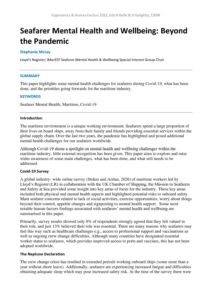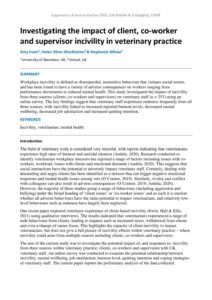Mental health & wellbeing
Staffing models in ergonomics/human factors
| Document | Author Colin G. Drury and Catherine Drury Barnes |
| Abstract The level of staffing in an organisation is an important determinant of both the organisation’s effectiveness and of the workforce wellbeing. To predict staffing we need to know the work content of the enterprise. This was comparatively simple when the main work content was repetitive tasks, with total output measured in numbers of identical items produced per unit time. This is not the situation with most modern work, where more complex tasks performed by teams are more common, for example nursing or maintenance. Unfortunately staffing is not well-represented in the ergonomics/human factors (subsequently referred to as human factors) literature, for example in an Ergonomics Abstracts search. More literature is in trade journals, and in the industrial/organisational psychology literature. Specific staffing models have been developed for specific situations, and later applied to analogous enterprises. There are two types of model, depending on how the data are collected and analysed. Models of existing staffing levels use staffing data from a number of enterprises to predict the staffing needs of other enterprises with analogous tasks. For example, in nursing there is much data on existing staffing levels across sites in a health service, such as the UK’s National Health Service. We can examine the staffing levels and concomitant input and process variables to determine how input variables correlate with overall nursing staff levels. The alternative method is summation of task times: if we know the time for each task, then we can sum across all of the tasks in a job to find the total workload and hence the number of staff to meet that workload. The estimates of time per task can come from historical data such as timesheets and work order records, from estimates by subject matter experts or from one of the various time study techniques. Staffing models are needed in human factors, so we need to access literature outside the immediate profession. |
Flexible Working and Wellbeing in Manufacturing
| Document | Author Lydia Elvin & Ella-Mae Hubbard |
| Abstract This study aims to assess the impacts working from home has had on employee wellbeing, due to the COVID-19 pandemic. Using data collected from a flexible working trial within a manufacturing organisation and a mixed method approach, the wellbeing scores between UK lockdown one and lockdown two will be compared, and different demographics considered. The findings revealed that participants experienced various impacts, which both positively and negatively affected their wellbeing. |
Sustainable management of job (re)design: A position paper on balancing competitive advantage and organisational performance to ensure healthy workplaces
| Document | Author Christine Ipsen, Kasper Edwards, Giulia Nardelli and Kathrin Kirchner |
| Abstract The risk of work-related stress and the high costs associated with it in combination with a proactive focus has initiated an interest from research and practice on what works. Regarding potential solutions, this has also motivated a discussion on how to ensure a joined focus on both organisational performance and wellbeing. Worldwide, companies are beginning implement new ways of working and organising work that takes into account both employee wellbeing and organisational performance, also coined as sustainable management. The idea behind sustainable management is to be proactive to prevent stress and ensure wellbeing by adjusting how work is designed, organised and managed and ensure organisational performance. Pioneering organisations across industries offer some inspiring examples illustrating a combined focus on organising and managing both organisational performance and employee wellbeing. Companies such as V2C, IIH Nordic, and Pentia in Denmark and SAS Institute, Patagonia, Hilton and Cisco Systems in the US offer examples of initiatives focused on shorter workweeks or less overtime – initiatives linked to improvements in both employee wellbeing and organisational performance. While the interest is high, examples are few and there is a pressing need for new knowledge about how redesigning of jobs can include the concern for both organisational performance and employee wellbeing in tandem. This study aims to further the discussion on management of job (re)design. We focus on how managers and workplaces can ensure both organisational performance and employee wellbeing in practice by focusing on prevention, job design, organisational design and business models. |
Using Cognitive Work Analysis to Evaluate Psychological Wellbeing in School-based Camps
| Document | Author Michaela E. Schuler, Gemma J. M. Read, Clare Dallat and Paul M. Salmon |
| Abstract Every year, large numbers of school students attend residential camps in Australia and around the world. While it is assumed that these experiences promote psychological development and wellbeing through exposure to novel environments and challenges, little research has evaluated the extent to which camps facilitate psychological well-being (PWB). This study represents a novel application of Cognitive Work Analysis (CWA) to describe the current residential camp system, providing insight into how the current design of school-based residential camps support PWB. The Six-Factor Model of PWB was adopted, which proposes six dimensions of PWB: self-acceptance, positive relations with others, environmental mastery, purpose in life and personal growth. The first phase of CWA, Work Domain Analysis, was used, with an initial model developed by the researchers and validated through workshops with nine subject matter experts. The model indicates that some PWB dimensions are well supported in the current system (e.g., positive relations with others), while others (e.g. purpose in life and personal growth) are less well supported. Further, the model provides insight into which functions or activities support which PWB dimensions, enabling changes to be made to the design of camps to better support specific dimensions. |
Occupational Health Survey among Indian Postal Workers during COVID-19 Pandemic
| Document | Author Somnath Gangopadhyay and Sayantika Das |
| Abstract In December 2019, the Corona-virus-disease (COVID-19) outbreak was first reported in Wuhan, China. Later on 11th March 2020, World Health Organisation declared this COVID-19 as pandemic. At present, worldwide more than 30 million people get infected by this. To suppress the frequency of the consequences of this disease when India went into complete lockdown, the largest postal network in the world i.e. Indiapost has become a lifesaver. Even in this critical situation, Indiapost is serving our country by delivering medical equipments including COVID-19 testing kits, ventilators, PPEs, medicines and unlike world-post providing essential financial services even in doorstep. The workers who are providing these tireless services to our nation must not be ignored, so the aim of the present study is to assess their health challenges among postal workers due to COVID 19, using the knowledge of Ergonomics. This is a cross-sectional study performed using online survey procedures from April 1 to September 1, 2020. Study participants were 310 postal workers from different states of India. Among study participants greater number of postal workers both male and female had complained about unintentional panic, sleep deterioration, acute headache than acute body ache. This study can conclude that during this COVID-19 there was both physical and psychological health challenges faced by postal workers but a higher prevalence of psychological symptoms among postal workers were found. These can be mitigated by proper sleep during night, avoiding discussing about panic news for longer time, practicing simple and regular exercises or yogasana etc. |
Assessing (dis)comfort: measuring motion sickness progression
Physical and social isolation in various places of work
| Document | Author Anne Aidla, Helen Poltimäe, Kärt Rõigas & Eneli Kindsiko |
| Abstract Our results indicate that dealing with the consequences of physical and social isolation may be an issue not only for teleworkers but also for non-teleworkers. What is more, both types of isolation may manifest differently depending on the office type (single cell, shared cell, activity-based or open-plan) and the amount of time one works in the same room with co-workers. |
Ergonomics in the informal work-systems of developing countries; need not luxury
| Document | Author Adedoyin A. Adeleye |
| Abstract In most industrially developing countries, artisans/tradesmen in the Informal work-systems are significant drivers of the economic life. Some simple, intuitive participatory ergonomics interventions hold great potentials to make a big difference, even if sometimes subtle, in this work milieu. The application of such interventions would increase the practitioners’ productivity and income. |
Preventative solutions from a systems perspective: Outcomes of a co-creating process among executives and researchers
| Document | Author Christine Ipsen and Signe Bergmann |
| Abstract Stress is still one of the biggest challenges when it comes to people’s mental health and workplace opportunities to create growth and wellbeing puts new demands on managers to solve the problem. There is also a stronger focus on top executives and managers, who play a key role in preventing and managing stress, but without a clear picture of what that role implies. There are plenty of international tools and methods available to support interventions to prevent stress, but managers still search for ways to deal with the increasing and costly problem. This search also includes two Danish companies, the Danish Association of Managers and Executives (DAME) and the Danish Pension and Insurance Company, (PFA) which experience an increase in the request for concrete knowledge and tools from their members and customers to solve this problem. Besides applying their vast in-house consultants’ experience to serve their members, the two companies also wish to provide their customers and members with current, relevant and research-based knowledge on how to prevent stress in practice. Acknowledging the experience and knowledge among executives, managers and researchers, the aim of this project was to allow these actors inspired by Mode 2 knowledge production to co-create new knowledge on preventative strategies. The idea is that the joint knowledge production in combination with a systems perspective on prevention and stress management can qualify the ongoing stress and management debate and provide ideas for new solutions, enhancing the implementability of stress preventive changes that can ensure both business relevance and improved mental health. |
Digital Well-Being Across the Ages – Generational Perceptions of Well-Being in Reference to the Use of the Internet and Digital Technology
| Document | Author Barry KIRBY, Jamie-Lee BIRCH, Jasmine CAIN and Victoria NEWLAND |
| Abstract Digital well-being is an extension of the concept of well-being centered around the use of the online and digital world. It is popular to assume the older generations are unsafe and lacking in engagement when discussing the use of the online world and digital skillsets; thus, a potential threat to the development of technology and concepts such as the Internet of Things, Smart Cities and Smart Communities. This paper explores the differences in attitudes towards digital well-being between older and younger generations. |
Envisaging regenerative futures through Good Work Design
| Document | Author Elise Crawford, Sara Pazell & Nektarios Karanikas |
| Abstract As we move towards a fifth industrial revolution, concerns about the future of work are heightened. To answer the call for work that we all want, this paper extends the concept of Good Work Design (GWD) introduced by the Human Factors and Ergonomics Society in Australia in 2020. Following an overview of GWD, we present a list of respective features with the purpose to advance a humancentred design-led approach to workplace strategy that reconciles business success with worker health. Moreover, we argue that effective design practice should be regenerative, expanding capacity and capability for design throughout the organisation, while supporting sustainable futures. The goal of this paper is to stimulate ongoing debate, research, and practice in good work design. |
Working environment effects of agile-stage-gate in manufacturing SMEs
| Document | Author Kasper Edwards |
| Abstract Agile-stage-gate is a hybrid product development methodology which combines agile methods such as SCRUM with overall portfolio management from Stage-Gate®. Agile development methods are known from software development and have seen extensive use the past ten years. Agile methods are participatory and empowering as the development team with concrete technical knowledge and not a manager should make the technical decisions for the product. Agile organises work in specific ways and stipulates methods and artefacts to be used. Agile projects are typically organised as a series of sprints each with a specific focus and tasks to be completed. Agile projects are described as having a positive impact on working environment. This paper describes a test of agile-stage-gate in three Danish SMEs and the impact on the working environment. It is hypothesised that use of agile-stage-gate will lead to an increase in wellbeing at work. Results show general but non-significant decline of the working environment possibly influenced by contextual factors. This questions the assumed positive effect of agile development methods and highlights the importance of analysing the impact of contextual factors in intervention research. |
PEGASO Project – Teenage Perspectives of an Integrated Technology Platform for the Promotion of a Healthy Lifestyle
| Document | Author Alexandra LANG, Laura CONDON, Neil COULSON, Sue COBB, and Sarah ATKINSON |
| Abstract This paper presents the findings from a participatory technology development workshop with teenagers. Sixteen teenagers were recruited in the East Midlands region of England to participate in the evaluation and development of the PEGASO multi-technology system. This system is being developed to promote awareness and motivation for healthier behaviours in teenagers. The teenagers critically analysed early prototypes of mobile apps, a serious game and wearable sensors with regards to their usability, acceptability, intuitiveness and desirability for teenage users. The results reported here will be utilized in the next design iteration of the PEGASO platform. |
A discussion relating individual performance evaluation and mental health: Research conducted in public services in Brazil
| Document | Author Laerte Idal Sznelwar, Ruri Giannini, Daniele Pimentel Maciel and Selma Lancman |
| Abstract The results presented here are related to the research ‘Construction of intersectoriality in the health and work field: Perspective of professionals inserted in the service network of the city of São Paulo’. The main objective of this research is to understand, through the approach of psychodynamics of work (PDW), the work processes of various actors that are in the frontline of the implementation of different policies (Brasil, 2011). One of the main issues that emerged throughout the research concerns the relationship between work and performance appraisal systems, more specifically in the Labour Court. From the evidence already obtained, we can consider that the performance evaluation systems disregard the real work – they are based on production goals defined from strategic objectives adopted without considering what judges actually face, as well as the servitors who work in support teams. There is still a great distortion regarding alignment with the values of the profession. Often, when seeking to achieve goals, other issues are relegated, such as treating cases with stronger degrees of complication, as if they were similar to others considered as routine. Another distortion is that there is not really an engagement in improving the quality of work – there are almost no organisational devices for discussion and feedback. The main purpose is to meet deadlines and goals regarding production volumes rather than to analyse and increase the usefulness of the performance of these public actors. As these evaluation processes, different reward modalities such as promotions and getting more resources, are also involved, there is an even greater distortion, even if this puts different actors in a difficult situation regarding ethical issues. The emergence of pathogenic suffering is one of the mental health consequences of judges and servitors. |
Nature as a New Paradigm for Ergonomics and Well-being
| Document | Author Miles RICHARDSON and David GOLIGHTLY |
| Abstract |
Do plants in an office improve perceptions of wellbeing and work effectiveness? The case of a call centre
| Document | Author Andrew THATCHER and Anastasia KALANTZIS |
| Abstract Numerous empirical studies based on attention restoration theory have shown that plants in the workplace have the potential to have a positive impact on the wellbeing and effectiveness of workers. This study examines the impact of introducing plants into a call centre environment on the employees. A repeated-measures design with a sample of 32 call centre employees revealed a significant improvement in physical measurements of indoor environmental quality but no significant improvements in employees’ perceptions. These results are discussed in the context of the call centre work environment. |
Understanding Non-Fixed Ligatures amongst Adolescents: A Human Factors and Ergonomics Approach
| Document | Author Saydia Razak |
| Abstract The Children’s and Adolescents Mental Health Service (CAMHS) in-patient unit scoping exercise was a qualitative exploration to understand the increase in Non–Fixed Ligaturing (NFL) incidents at an NHS Mental and Community Health Trust. This exercise aimed to answer 3 questions: (1) What are the reasons behind NFL on the CAMHS unit? (2) When does NFL behaviour occur? and (3) How can staff better respond to and reduce NFL incidents? A Resilience Engineering approach by understanding safety-I (increased incidents of NFL) and extracting examples of Safety-II was combined with an insight to how work processes on the unit were carried out in line with “Work as Imagined” (policy) vs “Work as Done” (procedure). A triangulation of methods was used which consisted of analyses of incident reports, an observation of a shift, and semi-structured interviews with 9 members of staff. The highest number of incidents occurred between 16:00 and 19:59. The semi-structured interviews revealed a psychological underpinning behind NFL through the theme of the act of ligating. Seeing Work as Done (observation) resulted in an instant change of staffing. Safety-II was evident in effective workarounds such as accommodating unfamiliar staff through a succinct induction. The methods aligned with the safety management mode of guided adaptability providing a novel approach to produce usable tools and interventions in sensitive, volatile, and emotionally charged work environments. The CAMHS unit scoping exercise provides insights, implications, practical applications, and improvement opportunities to reduce and better respond to NFL across CAMHS units by adopting a HF/E approach. |
Informing stress management. A research project focusing on mental health professionals in training.
| Document | Author John GALVIN and Andrew SMITH |
| Abstract This article presents an overview of a research project that focuses on stress in clinical psychology trainees and mental health nursing students. As these groups are exposed to a variety of stressors, a multi-dimensional approach to stress is required. Qualitative and quantitative methods were used to investigate stress in these groups and some of the key findings from these studies are discussed. This approach provides a more comprehensive account of the factors influencing stress levels and allows future interventions to be more informed, and be of particular relevance, to these groups of students. |
Prevalence of Physical Health Symptoms in Police Officers
| Document | Author Kenisha V. NELSON |
| Abstract This study reports on the prevalence of physical health symptoms in Jamaican police officers (N=134) and examines associations between these and gender, age, rank and years of service. The relationships between number of reported symptoms and sickness and doctor visits were also examined. Participants completed a questionnaire using a cross-sectional design. Over 50% of participants reported backache, frequent headaches, heartburn or indigestion, and sleeping problems. Few significant relationships were found with demographic variables and symptoms. Significant relationships between number of symptoms, sickness absence and doctor visits were observed. Implications of the findings and suggestions for future studies are discussed. |
Significant event analysis: a systems approach to exploring personal impact and improving the analytical process in primary care
| Document | Author Paul BOWIE, Elaine MCNAUGHTON, Deirdre HOLLY, John MCKAY and David BRUCE |
| Abstract |
Occupant psychological wellbeing and environmental satisfaction after an open-plan office redesign
| Document | Author Jennifer Langer, Andrew Smith & Jim Taylour |
| Abstract Open-plan office layouts are commonly used due to perceived economic benefits; however, studies have shown negative occupant wellbeing outcomes associated with this office type. A recent trend in open-plan office design is activity-based, or agile working, which has been associated with positive occupant outcomes. Open-plan offices can vary in features and design, and the present study explored how improving occupants' environment may affect their psychological wellbeing. This case study investigated changes in office workers' environmental satisfaction and psychological wellbeing outcomes after their agile working, open-plan office was redesigned. Environmental satisfaction of occupants increased significantly after the office redesign by 31%, and nine out of 11 environmental satisfaction items were rated significantly higher. After the redesign, occupants reported significantly less control over their job and support from colleagues, and significantly more often feeling anxious or depressed because of work. There were no significant changes in other aspects of psychological wellbeing measured (job demands, stress at work, job satisfaction, fatigue, job performance, life / work balance, and happiness at work). At the time of the post office design measures, there were some changes occurring in the office due to company expansion, which may have affected the results. This study suggests that increased environmental satisfaction alone, may be insufficient to improve employees' psychological wellbeing, and other factors, such as work demands and stressors, need to be considered. |
Systems approach to analysing suicide incidents in community-based mental health care
| Document | Author Nye Canham, Gyuchan Thomas Jun, Satheesh Kumar & Fabida Noushad |
| Abstract Mental health services in the UK are now predominantly community-based, rather than inpatient-based. Managing patients with suicidal risk within the community setting is challenging and suicides from those currently using or having recently used these services do occur. More than half of the people who commit suicide have visited their doctor in the month before their death. In current practice within the UK health service, patient suicides are investigated as serious incidents and analysed using Root Cause Analysis (RCA) but this method has limitations in exploring deep system problems. This study reanalysed 41 of these RCA incident reports using Systems Theoretic Accident Modelling and Processes (STAMP). The analysis revealed the weaknesses within the system safety control structure and the themes around those control flaws. An inherent weakness in the control structure is the need to monitor the patient’s risk without constant observation and relying on the patient to report issues and adhere to their treatment plan. Patient engagement issues are a major theme with loss of control and feedback on the patient status due to their lack of willingness to engage with services and treatment options. In some cases, patients have presented at a time of crisis but then declined the crisis support or inpatient treatment offered to them. Patients new to services present a problem where decisions on their care have to be made with limited knowledge of the patient. Certain coordination and communication issues between the multidisciplinary teams and multiple services are also found. In this study, STAMP application enabled effective aggregation of multiple incident analysis and system-wide remedial action prioritisation. |
Seafarer Mental Health and Wellbeing: Beyond the Pandemic
| Document | Author Stephanie McLay |
| Abstract This paper highlights some mental health challenges for seafarers during Covid-19, what has been done, and the priorities going forwards for the maritime industry. |
A short questionnaire to measure wellbeing at work (Short-SWELL) and to examine the interaction between the employee and organisation
| Document | Author Andrew SMITH and Hugo SMITH |
| Abstract The aim of the study was to develop a short measure of wellbeing at work which includes the interactions between the individual and the organisation. This was presented in an online survey to 210 employees doing a range of jobs. Regression analyses showed that positive wellbeing (e.g. job satisfaction; happiness) was predicted by a positive personality whereas negative wellbeing (stress; anxiety/depression) was predicted by negative job characteristics and passive coping. Organisational factors did not predict wellbeing. |
Investigating the impact of client, co-worker and supervisor incivility in veterinary practice
| Document | Author Amy Irwin, Helen Silver-MacMahon & Stephanie Wilcke |
| Abstract Workplace incivility is defined as disrespectful, insensitive behaviour that violates social norms, and has been found to have a variety of adverse consequences on workers ranging from performance decrements to reduced mental health. This study investigated the impact of incivility from three sources (clients, co-workers and supervisors) on veterinary staff (n = 252) using an online survey. The key findings suggest that veterinary staff experience rudeness frequently from all three sources, with incivility linked to increased reported burnout levels, decreased mental wellbeing, decreased job satisfaction and increased quitting intention. |

